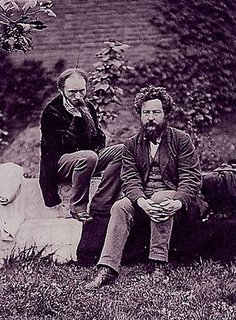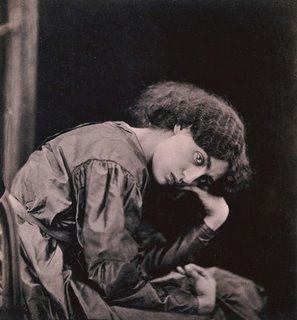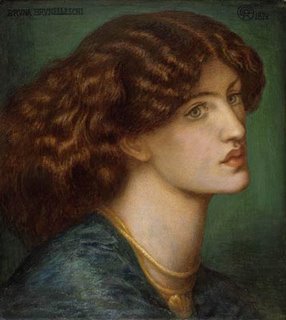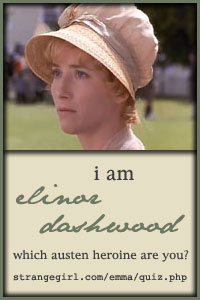Summer Reading Challenge: A Circle of Sisters
The second book I read for the Summer Reading Challenge was A Circle of Sisters by Judith Flanders. Here's the publisher's summary:
The Macdonald sisters Alice, Georgiana, Agnes and Louisa-started life in the teeming ranks of the lower-middle classes, denied the advantages of education and the expectation of social advancement. Yet as wives and mothers they would connect a famous painter, a president of the Royal Academy, a prime minister, and the uncrowned poet laureate of the Empire. Georgiana and Agnes married, respectively, the pre-Raphaelite painter Edward Burne-Jones and the arts administrator Edward Poynter; Louisa gave birth to future prime minister Stanley Baldwin, and Alice was mother to Rudyard Kipling.
This was a fabulous book - even better than May and Amy. With this cast of characters how could you go wrong?
I really enjoyed reading about the "famous four" MacDonald sisters and their respective families.
Louisa, who married Alfred Baldwin and became the mother of Stanley Baldwin, was the only sister to start off her married life in prosperous circumstances, Alfred was a successful busisnessman. Her portrait was painted in 1868 by her brother in law Edward Poynter.

Louisa became a mildly successful writer later in her life, penning formulaic romance novels and unremarkable poetry. Although it's artistic worth is doubtful, Louisa's writing helped her to carve out a fulfilling personal life for herself - something which to a large extent her sisters were unable to do. She also spent much of her life as the stereotypical Victorian invalid lying upon the couch with some vbague and mysterious malady - although Louisa's illnesses always seemed to clear up enough to enable her to travel.
Poynter was married to Agnes, seen here in his 1867 portrait of her. Note the painting by Rossetti in the background.

Agnes and Louisa were the closest to each other among the sisters, both emotionally and physically - they spent a large part of their adult lives living near each other. Agnes also put in her time as an invalid on the couch. Indeed, only Georgie seems to have totally avoided playing that role.
There was actually a fifth sister, Edith, who was the youngest. She never married and she seems to have been considered almost as an afterthought by the rest of the family. Poor Edith fulfulled the role that so many Victorian youngest daughters did, that of thankless companion, first to her elderly mother and then to her sister Louisa, with whom she lived for most of her life. Fortunately Edith also wrote some memoirs of her family which were drawn on by the author for this book.
I couldn't find a photo of Edith to include here, nor could I find one of the eldest sister Alice. She apparently disliked being photographed. She was described as a "serial fiance" until she finally met and married her soulmate, Lockwood Kipling. She accompanied him to India where Lockwood taught art and championed the native handicrafts and artisans. Their son was Rudyard Kipling who probably needs no introduction.
Rudyard actually comes off rather poorly in this book. He is selfish and self-absorbed. He repeatedly fails to financially assist his family members - even when they were in appaling circumstances and he was fabulously wealthy. His wife Carrie is portrayed as a selfish social-climber of a woman and was disliked by most of the family. Perhaps that explains some of Rudyard's emotional distance from his family when coupled with the fact that (although with the best of intentions) he was virtually abandonded as a child by his parents. He and his sister Trix were raised by "friends of the family". But mainly it seems that it never occured to Rudyard to part with any of his money.
Trix was a fascinating character and I would have liked to have known more about her. She suffered some type of "psychotic break" as an adult and ended up seriously mentally ill for the rest of her life. The circumstances surrounding Trix's life and breakdown were left rather vague in the book. Perhaps the author simply could not get information about what went wrong.
Georgie was of course, married to Edward Burne-Jones, the Pre-Raphaelite painter - seen here in this photo with his best freind William Morris.

The Morris and Burne-Jones families were close although Georgie didn't really "get on" with Morris' wife Jane Burden.

Jane famously had a long affair with painter Dante Gabriel Rossetti, in between her long periods of lying about as an invalid on the couch. Morris unfortunately probably knew all about Jane's affair. It's seems that neither party did much to hide it. Given her own experience with her husband's infidelity, Georgie probably found it hard to like Janey. Rossetti was tremendously inspired by Jane and she became his most famous muse.

For his part Morris eventually fell in love with Georgie, who refused to let the situation develop into an affair. As time went on, and both were relentlessly betrayed by their spouses, Morris and Georgie developed a strong emotional reliance on each other. Towards the end of their lives, Morris was more Georgie's friend than Burne-Jones' (who typically failed to recognize this). Morris and Georgie shared their socialist political views and Morris encouraged Georgie to run for public office.
This was a great book. I love to read about women's lives (especially when written by a woman), the Victorian time period, extended family dynamics and the Pre-Raphaelites - so this book was well suited to me! I plan to read more by this author as soon as her new book comes out.







 David Copperfield by Charles Dickens
David Copperfield by Charles Dickens Shakespeare by Another Name by Mark Anderson
Shakespeare by Another Name by Mark Anderson Marie D'Agoult: The Rebel Countess by Richard Bolter
Marie D'Agoult: The Rebel Countess by Richard Bolter Hans Holbein by Derek Wilson
Hans Holbein by Derek Wilson Dolly Me
Dolly Me











0 Comments:
Post a Comment
Subscribe to Post Comments [Atom]
<< Home